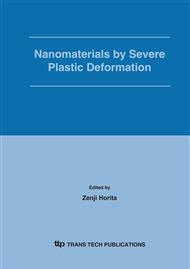p.687
p.693
p.699
p.705
p.711
p.717
p.721
p.727
p.733
Microstructure, Texture and Property Changes of High Purity Aluminium during Accumulative Roll Bonding and Conventional Rolling
Abstract:
It is known that the severe plastic deformation (SPD) induced by Accumulative Roll Bonding (ARB) results in more important grain refinement as compared to conventional rolling. Since ARB enables production of large amounts of ultra-fine grained (UFG) materials, its adoption into industrial practice is favoured. The paper presents the results of a study of high purity aluminium processed by ARB and cold rolling. Microstructure changes induced by both methods were studied by light and transmission electron microscopy. Dislocation density and arrangement were assessed by positron annihilation spectroscopy. Strength evolution was estimated by hardness measurements. Texture measurements were performed by X-ray diffraction. ARB processing results in over twofold increase in hardness. Hardness increases significantly after two ARB cycles and it raises only a little or decreases during subsequent cycles. The increase in hardness induced by conventional rolling is smaller. Positron lifetime measurements reveal a substantial increase of dislocation density at the first ARB cycle and a moderate increase or even a decrease at further cycles. The high fraction of positrons trapped at grain-boundary dislocations gives evidence for substantial grain refinement confirmed by TEM examinations. Grain size of 1.2 m in the rolling plane and as small as of 90 nm in the normal direction is obtained. The rolled samples have a typical rolling texture (-fibre). The - fibre of the sample ARB processed to strain of 2.4 is weaker as compared to its rolled counterpart and it presents through thickness variations. The surface layers do not have any -fibre orientations but they have ND-rotated cube texture formed by the shear strains induced by lubricant-free rolling.
Info:
Periodical:
Pages:
711-716
Citation:
Online since:
January 2006
Price:
Сopyright:
© 2006 Trans Tech Publications Ltd. All Rights Reserved
Share:
Citation:


